Cu(ii) sorption by biogenic birnessite produced by Pseudomonas putida strain MnB1: structural differences from abiotic birnessite and its environmental implications†
Abstract
Biogenic birnessite is the most prevalent form of Mn-oxide in nature and it plays important roles in controlling the mobility of heavy metals such as Cu(II). This study focuses on the fine mineralogical characteristics of Cu(II)-incorporated biogenic (bio-) birnessite produced by the Pseudomonas putida strain MnB1, and discusses the structural stability of Cu-binding birnessite. Compared to the structural analog, hexagonal (abio-) birnessite, the X-ray diffraction (XRD) patterns of bio-birnessite showed an enlarged interlayer space from 7.33 to ∼9.17 Å. The reduced in-plane crystallinity and increased lattice parameter b were indicated after Cu(II) adsorption. The linear combination fitting of the Mn K-edge X-ray absorption near-edge structure (XANES) indicated ∼13% Mn(II), and only a small amount of Mn(III) was present. The saturated sorption amount of Cu(II) was 0.17 and 0.25 mol Cu/mol Mn for bio- and abio-birnessite, respectively. By conducting extended X-ray absorption fine structure (EXAFS) spectroscopic analysis, multiple coordination paths of Cu–Mn ∼2.85 Å, Cu–Cu ∼3.00 Å and Cu–Mn ∼3.43 Å were shown to exist in both bio- and abio-birnessite, showing the diversity of the Cu coordination structure. The fitted coordination numbers for these three paths were much larger (with identical Debye–Waller factors) in bio-birnessite (1.9, 1.9 and 2.5, respectively) compared to abio-birnessite (1.1, 1.1, 1.6), indicating that Cu had more surrounding atoms in bio-birnessite. The results indicate that Cu sorption by vacant sites, i.e. incorporation into the vacancy (INC species) or adsorption on the vacancy (TCS species), was more dominant for bio-birnessite, which may have benefitted from the larger interlayer space for accommodation of the Cu inner-sphere complex and the very low content of structural Mn(III) competing for vacant sites. In turn, the Cu inner-sphere complex modified both the layer and interlayer structures of bio-birnessite. In abio-birnessite, Cu binds favorably at abundant edge sites as dimers or multinuclear clusters, which contributes to a larger sorption amount. This binding style was depressed in bio-birnessite because the organic ligands released by microbial activity could block the layer edges. Theoretically, the structural stability of Cu clusters at the edges should be weaker than the TCS and INC species. This work also provides insight into the geochemical behaviors of Cu(II) controlled by widespread biogenic birnessite.



 Please wait while we load your content...
Please wait while we load your content...